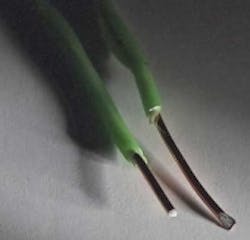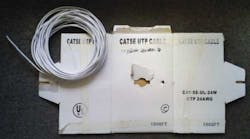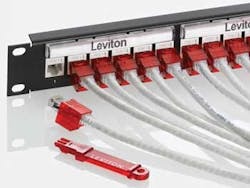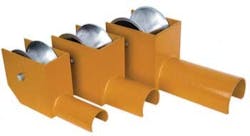Copper-clad aluminum conductors the latest counterfeiting ploy
Compiled by Patrick McLaughlin
The Communications Cable and Connectivity Association (CCCA; www.cccassoc.org), along with the Copper Development Association (CDA; www.copper.org), recently issued an alert about the presence in the market of twisted-pair cables with copper-clad aluminum conductors rather than solid-copper conductors.
The CCCA and CDA pointed out in their recent release that such conductors violate several industry standards,Several sets of specifications require solid-copper conductors within multi-conductor communications cables. In addition to UL 444, there's the National Electrical Code and TIA-568-C.2. Section 800.179 of the NEC says, "Conductors in communications cable, other than in a coaxial cable, shall be copper." UL 444, officially titled Standard for Communications Cable, states in Section 5.1.1, "The conductors shall be solid or stranded, annealed, bare or metal-coated copper." As the CCCA and CDA point out, UL 444 compliance is a basic requirement for any communications cable to receive fire/safety ratings from UL or other nationally recognized test laboratories. Section 5.3 of TIA-568-C.2 requires compliance with ANSI/ICEA SS-90-661-2006 and ANSI/ICEA S-102-732, which both include the following: "Solid conductors shall consist of commercially pure, annealed, bare copper ..."
CCCA chairman Kevin Ressler acknowledged that contractors purchasing twisted-pair cable may be unaware that if it is copper-clad aluminum it does not meet the above-referenced codes and standards. In part, that is because the production of cable with copper-clad aluminum conductors is a relatively recent turn of events. Ressler pointed out that determining a cable is so constructed is relatively easily accomplished, by scraping the thin copper surface to reveal the aluminum.
The CDA's president Andy Kireta said, "As an organization, we place high confidence in industry codes and standards and support products that fully comply. The codes and standards that serve the structured cabling industry reflect copper's long history of performance and its remarkable capacity to meet network speeds that seemed impossible only a few years ago. We applaud CCCA's focus on cable compliance and product-quality issues, which improves and strengthens this vital industry."
The CCCA continued to drive home its theme of purchasing known brands from quality distributors. The group's executive director Frank Peri said, "When dealing with lesser-known brands, users should consider asking for complete documentation of product specifications, in writing, to confirm the product meets recognized industry standards. Users should also carefully examine cable for proper marks and labels to show it has been verified or listed by an independent third party such as UL or Intertek/ETL. As an added measure, UL and ETL Website directories can also be checked to assure cable manufacturers are in compliance and authorized to display the appropriate mark."
Jim Hayes, who heads up The Fiber Optic Association (www.thefoa.org) and VDV Works (www.vdvworks.com), recently reported receiving some Category 5E unshielded twisted-pair cable with copper-clad aluminum conductors. "A contractor called me recently and said he had some cable that was hard to install and would not certify," Hayes said. "[Later] he called to say they found the problem: The wire was not copper but copper-plated aluminum."
After receiving the cable, Hayes took the photos that accompany this story. He noted that when taking the photos he "tried to get some close-ups of the wire. It was so brittle I had great difficulty stripping it. I finally had to grind the wire at an angle to get a useful photo."
As can be seen in the photos, the cable jacket has "UL Verified" inkjetted on it, and the box includes the UL logo.
Keyed 8P8C system for added security
The new Secure RJ Copper System from Leviton Network Solutions (www.leviton.com/networksolutions) serves as a measure of protection against mistaken or malicious moves, adds and changes. Leviton points out the potential environments in which the secured system can be deployed for security measures: data centers and collocation facilities, confidential government networks, educational facilities, healthcare, retail and financial institutions.
Additionally, Category 6 and Category 6A patch cords with the Secure RJ housing on just one end can prevent patch-cord theft in publicly accessible spaces.
The system's port-blocking mechanism is a patent-pending device that can be released only by a matching extraction tool. The full Secure RJ Copper System includes patch cords, trunks, port blockers and extraction tools. Leviton points out the system's features support multiple applications within enterprise data networks. It is compatible with high-density network equipment and 1RU, 48-port patch panels, as well as with all flush-mount and most recessed RJ ports. The system's port blockers can be used to prevent access to unused network ports. Eight color options are available to reserve, identify, segregate and secure ports. And the housings, made of transparent polymer, enable port security without blocking the visibility of link/status LEDs on electronic equipment.
Senior copper product manager for Leviton Network Solutions Keith Kosanovich said, "Data security and reliability are top priorities for enterprise networks today. The Secure RJ System addresses these needs by ensuring secure connectivity in high-priority network ports, even in high-density data centers, telecommunications rooms and work-area applications."
The system joins the Secure LC System in Leviton's line of keyed connectivity solutions.
Sheaves facilitate pulls in underground conduit
The Cable Feeding Sheaves from General Machine Products (GMP; www.gmptools.com) are the newest additions to the company's line of products for installing copper cables underground. Fiber-optic cable bend-radius requirements restrict the sheaves from use with that cable type.
GMP says the sheaves speed up installation time, reduce strain on installation technicians, and minimize the extent to which cables can slip during an underground install.
They are available in multiple sizes, accommodating 2- to 6-inch Schedule 40 and Schedule 80 ducts. According to GMP, using the sheaves is not complicated. The technician slides a sheave into the end of a conduit and rotates it to align with the desired cable direction. Doing so allows the cable to be fed-in smoothly from any angle.
The sheaves are made of steel and incorporate a half-circle, split-tube design that the company says allows for easy insertion and removal. Rollers are available in aluminum alloy or Nylatron.
Guide assists with IP-video planning
The IP Video Security Guide from Pelco (www.pelco.com) is a free, downloadable 43-page document meant to help IP-video security system designers, installers and users develop the most appropriate approach to IP video.
The guide's first page explains its purpose and includes the following: "Greater responsibility is being placed on IT professionals to design, integrate and administer their video security components without compromising network integrity or performance. Today's converging network technologies require increased bandwidth, Quality of Service for prioritized traffic, and the transmission of all IP-based technologies over a common network." The guide urges users to consider the following factors before setting up their own systems. 1) Features. 2) Performance. 3) Scalability. 4) Flexibility. 5) Cost. 6) Future expansion.
The first two sections of the guide cover the benefits of video-over-IP and an introduction to network video security. Following sections explain video formats, the impact on network performance, infrastructure design and topology, protocols, alarms, lenses, camera features, PTZ camera control and configuration, and recording methods and storage options. The final three sections cover IP-camera purchase considerations, system design, and Pelco's Global Training Institute.
Scissors cut wire and Kevlar
The Wire Surgeon scissors from QuickTrex (www.quicktrex.com) cuts wire as well as Kevlar and are made of ice-tempered Solingen stainless steel. They also incorporate a wire stripper and splice-and-terminal crimper that can be used on copper wires from 26 to 18 AWG.
The shear is designed for clean cutting, and slight serrations on the blade prevent wire slippage, QuickTrex explained. The scissors are suitable for left- or right-handed workers and include an ergonomically designed soft-rubber handle to diminish fatigue during use.
"Professional-grade tools for today's diversified installers and technicians are becoming more vital to success in this economy than ever before," said QuickTrex president and founder Tony Casazza, "because a quality tool will do a better job and last longer. It's good economics."
Past CIM Issues





